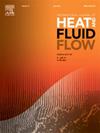Direct numerical simulation of turbulent heat transfer in a channel with circular-arc ribs mounted on one wall
IF 2.6
3区 工程技术
Q2 ENGINEERING, MECHANICAL
International Journal of Heat and Fluid Flow
Pub Date : 2024-11-16
DOI:10.1016/j.ijheatfluidflow.2024.109638
引用次数: 0
Abstract
Turbulent heat convection in a cooling channel roughened with circular-arc ribs of different pitch-to-height ratios (, 5.0 and 7.5) are studied using direct numerical simulations (DNS). The pitch-to-height ratio effects on turbulent heat transfer are studied through analyses of the first- and second-order statistical moments of the temperature field. It is observed that the local Nusselt number increases remarkably near the rib centre due to the flow impingement on the rib windward side. Furthermore, the overall thermohydraulic efficiency of the whole ribbed channel enhances dramatically as the pitch-to-height ratio increases. Meanwhile, the Reynolds analogy factor on the ribbed wall side decreases with an increasing value of , indicating that the effect of heat transfer enhancement is counterbalanced by that of increasing hydraulic losses caused by the ribbed wall. It is found that temperature variance weakens under the rib effects, and further decreases with an increasing value of . From the transport equation of , it is seen that both profiles of and its production term exhibit a dual-peak pattern at the midspan between two adjacent ribs, where the first peak near the wall enhances while the second peak in the internal shear layer weakens as the value of increases. The quadrant analysis of heated turbulent motions indicates that hot sweep and cold ejection events dominate turbulent heat fluxes near the ribbed bottom wall. Interestingly, both hot sweep and cold ejection events enhance in the internal shear layer around the rib height. However, this enhancement effect weakens as the value of increases.
单壁安装圆弧肋片的通道中湍流传热的直接数值模拟
通过直接数值模拟(DNS)研究了使用不同节高比(P/H=3.0、5.0 和 7.5)的圆弧肋条粗化冷却通道中的湍流热对流。通过分析温度场的一阶和二阶统计矩,研究了节高比对湍流传热的影响。结果表明,由于肋骨迎风面的气流冲击,肋骨中心附近的局部努塞尔特数显著增加。此外,随着螺距-高度比 P/H 的增大,整个带肋通道的整体热液压效率也显著提高。同时,肋壁侧的雷诺类比系数随 P/H 值的增大而减小,这表明传热增强的效果被肋壁造成的水力损失增加的效果所抵消。研究发现,温度方差〈θ′θ〉在肋骨效应下会减弱,并随着 P/H 值的增大而进一步减小。从〈θ′θ〉的输运方程可以看出,〈θ′θ〉及其产生项 Pθ 的剖面在两相邻肋片之间的中跨处都呈现出双峰模式,随着 P/H 值的增大,靠近壁面的第一个峰值增强,而内部剪切层的第二个峰值减弱。对加热湍流运动的象限分析表明,热掠和冷喷射事件在肋骨底壁附近的湍流热通量中占主导地位。有趣的是,热掠和冷喷射事件都会增强肋高附近的内部剪切层。不过,随着 P/H 值的增加,这种增强效应会减弱。
本文章由计算机程序翻译,如有差异,请以英文原文为准。
求助全文
约1分钟内获得全文
求助全文
来源期刊

International Journal of Heat and Fluid Flow
工程技术-工程:机械
CiteScore
5.00
自引率
7.70%
发文量
131
审稿时长
33 days
期刊介绍:
The International Journal of Heat and Fluid Flow welcomes high-quality original contributions on experimental, computational, and physical aspects of convective heat transfer and fluid dynamics relevant to engineering or the environment, including multiphase and microscale flows.
Papers reporting the application of these disciplines to design and development, with emphasis on new technological fields, are also welcomed. Some of these new fields include microscale electronic and mechanical systems; medical and biological systems; and thermal and flow control in both the internal and external environment.
 求助内容:
求助内容: 应助结果提醒方式:
应助结果提醒方式:


